Looking a Gift Horse in the Mouth: Horses’ Teeth
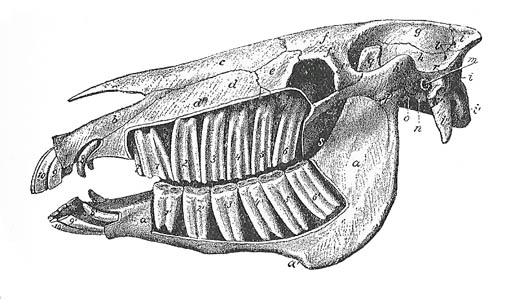
|

|
I have never looked a gift horse in the mouth. The truth is that I can never remember just how to estimate a horse’s age from its teeth, even though I have read about it several times. Because it is complicated to do, it is much easier just to look at a purebred horse’s papers or ask the prior owner. In the end if a horse is sound and serviceable when you acquire it, do you even need to know its age to the year? My eye knows the look and behavior of a young horse versus an older horse much in the same way you can estimate the age of people you meet. However, this is of historical interest because in times past horse traders needed to estimate a horse’s age by looking at its teeth. The important take home message is that a horse’s dentition is continually changing throughout its life in a characteristic fashion.
Needless to say, teeth are very important to a horse. Biting off grass and processing it is the first step in their digestion. That governs their survival as individuals and as a species. Horses’ teeth are highly evolved and specialized for this role and are certainly very different from human teeth. Horses very much want to graze and it is ingrained in their mentality as much as chasing mice is ingrained in cats’ mentality. One source of “nervousness” in horses that are confined to stalls is that they are unable to graze. If you stand with a grazing horse, they are fairly particular about what they choose to bite off and eat. If several different kinds of edible plants are there, they will go for certain ones preferentially. This time it might be orchard grass and at another time it might be clover or dandelions. I suspect someone has studied this behavior and it certainly allows for variety and better nutrition. There are also plants they avoid and that are not good for them; for example, buttercups.

| 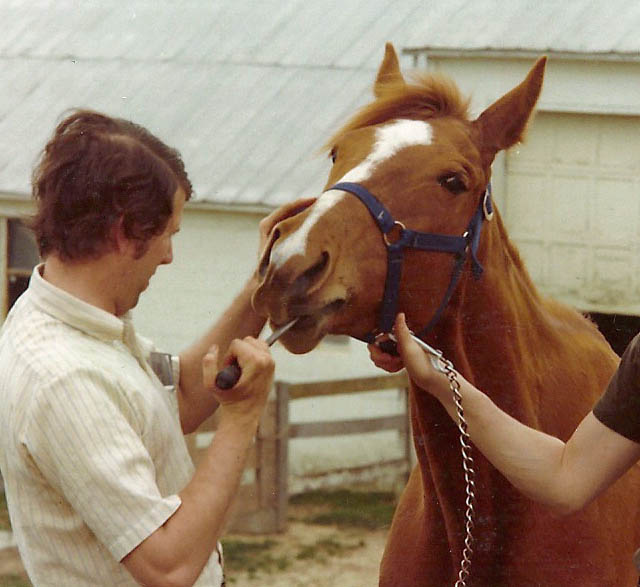
|
Mammals have four basic types of teeth: incisors, canines, premolars and molars. The ratio of these different types can be expressed in a dental formula which starts in the middle of the jaw and works backward on one side: upper on top and lower on bottom. For example the human formula is: 2.1.2.3 /2.1.2.3. A horse’s dental formula depends on its sex and has some variability. In a male horse it is 3.1.3-4.3 /3.1.3-4.3 and in a female 3.0.3-4.3 /3.0.3-4.3. Male horses have a vestigial first premolar (P1) known as a “wolf tooth” that is often removed in the belief that it can cause problems wearing a bit. About 25% of females also have these wolf teeth. It is this variation that accounts for the three or four premolar teeth in the dental formula. The second premolar (P2) is well-developed in all horses and the premolars and molars are so similar that equine premolars are said to be “molarized.”
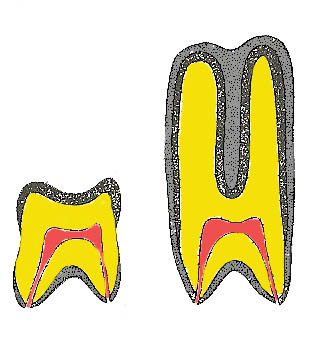
|
While we are talking about horses teeth, I should mention that they occasionally use them for reasons other than eating. A horse is fully capable of biting another horse or human. An older, well-mannered horse would never think of biting a person. I once got my thumb bitten when I held it in front of one of our horses’ mouths while loading her on a trailer. The horse mistook my thumb for one of the “horse cookie” treats we often give them, and I was occupied with securing the halter and was not watching the horse or my thumb when this happened. Once she had done this she was clearly upset that there would be some terrible retribution and stepped back with a horrified and anxious expression on her face. Domestic horses remember that they are not supposed to bite people, but this event was clearly an accident and not aggression on her part.
It happens that some horses do deliberately bite people and I have an example of that. There are wild ponies on Assateague Island, Virginia. A young mother wearing only a bikini walked up to the herd of wild horses. She turned around and bent down to pick up her child in order to show her the ponies. Of course, in doing so she presented a certain part of her anatomy to a nearby pony. It must have been just too much to pass up and the poor pony could not help himself. I am certain the lady learned a life lesson about approaching wild animals and maybe also had a little explaining to do to her husband about how she got that odd looking bruise on her rump.
Newborn mammals consume milk and do not need teeth at first. During the period from birth to several weeks old the fold’s deciduous (baby) teeth begin to erupt, and during the first five years of a horse’s life the month is continually gaining and losing various features that are used to estimate age. By the age of five years horses have all of their adult teeth and have lost the original set of deciduous teeth (baby teeth). After that there is a gradual wearing of the teeth and shrinkage of the gums.
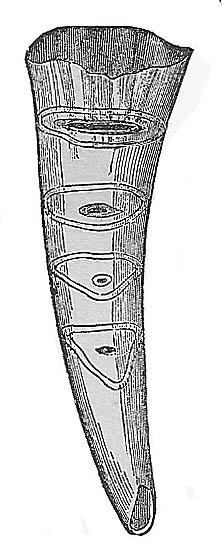
| 
| 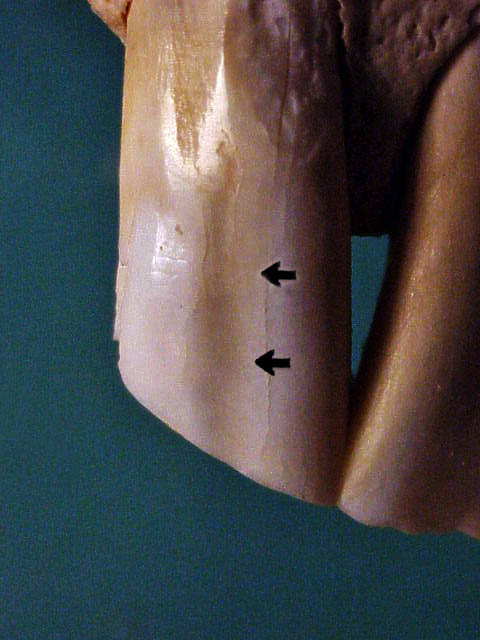
|
| Cross Section Diagram: Genesis of the Incisor Mark as the teeth wear | The Mark in the Second and Third Upper Incisor | Galvayne’s Grove on the Third Incisor |

|